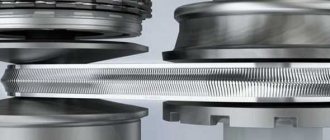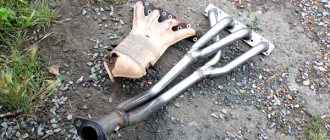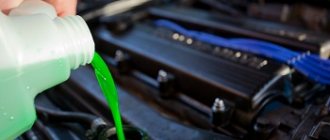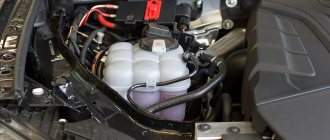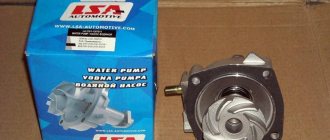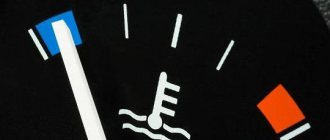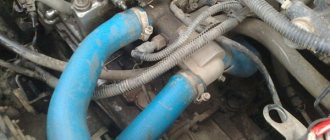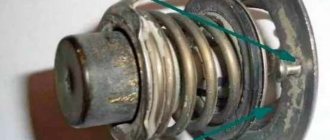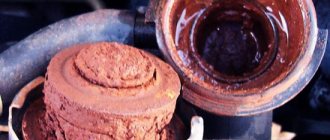What to pour Antifreeze or Antifreeze?
What is better - antifreeze or antifreeze ? Is it possible to mix them? How to choose the right coolant? These questions worry many novice car enthusiasts. Let's try to answer them and decide on the main question - what is better to fill, antifreeze or antifreeze ? Before moving on to the analysis, it is necessary to understand what coolant is, what it is needed for, and on what basis it is produced.
Characteristics of coolants
The task of any coolant (coolant) is to prevent the engine from overheating during operation. Previously, ordinary or distilled water was used in this capacity, but its use has a number of disadvantages, including:
- water will freeze in frost and boil at a temperature of +100°C , that is, it has a small operating temperature range;
- water negatively affects some elements of the engine cooling system, in particular, it exposes them to corrosion.
It was these shortcomings that once forced automakers to invent coolants based on a water-glycol composition. In the territory of the former USSR, the most popular coolants are liquids using ethylene glycol. In addition, to prevent corrosion of cooling system elements, anti-corrosion additives are added to the coolant. They come in two types:
- Silicate . Such compositions cover the inner surface of parts of the system with a small layer of scale. Due to this, the amount of thermal energy recirculation is reduced. As a rule, such coolants are green .
- Carboxylate . These compounds provide protection against corrosion in those places where it is most likely to occur by creating a protective layer. At the same time, carboxylate compounds have a longer service life, and when replacing coolant there is no need to flush the system. The color of such liquids is red .
This classification is the standard worldwide. However, at present, many manufacturers use various dyes in production, which make it difficult to identify a particular liquid.
Antifreeze and antifreeze, what's the difference?
What is the difference between antifreeze and antifreeze
First, let's give them definitions. Antifreeze (from the English word antifreeze - non-freezing) is a general name for liquids that do not freeze in the cold. In English-speaking countries, the term Antifreeze Coolant is used to define automotive antifreeze. There are separate brands of antifreeze, for example, GlasELF, GlycoShell, Havoline, Glysantin, Prestone.
“Tosol” is a separate brand of coolant. It first appeared in the USSR in 1971, when Zhiguli cars began to be produced on its territory. They required a coolant with improved performance characteristics, which were not available in the liquids produced at that time in the country. It was developed at the State Scientific Research Institute of OHT, in the department of organic synthesis technology. This is where the abbreviation TOS comes from. The ending “ol” means that the liquid belongs to alcohols.
Initially, “Antifreeze” had a composition specified by the state standard. But currently, manufacturers produce coolants based on their own specifications. Therefore, in Russia and the CIS countries you can find a variety of brands of Antifreeze with different quality, both high and below average.
Antifreeze is a broader concept that is used to define coolants. And antifreeze is one of its varieties. Such confusion in words arose due to the fact that after the collapse of the USSR, a large number of foreign cars appeared on the territory of the former Soviet republics, which required high-quality coolant. And in the minds of the population, antifreeze was associated only with Zhiguli cars. Therefore, enterprising businessmen began to call all coolants antifreeze. And the only coolant for Zhiguli is antifreeze.
There are two main types of antifreeze - regular and for northern conditions. The first has a freezing point of -40°C (blue), the second - -65°C (red). A distinctive feature of antifreeze is the use of ethylene glycol. That is, it is created on a mineral basis. The remaining components are various silicate additives. It has a low resource, about 30 thousand kilometers.
Foreign antifreezes, as a rule, are created using organic additives that are designed to reduce the level of oxidation of working surfaces at high temperatures. That is, they are made using more advanced technology.
Composition of antifreeze and antifreeze
Antifreeze is produced on the basis of ethylene glycol/glycerin/di-/triethylene glycol (“antifreeze agents”) or a mixture thereof. In addition, it contains water, dye and corrosion inhibitors (their composition differs for each manufacturer). Antifreeze is made on the basis of similar antifreeze agents, but with the use of organic additives. We present to your attention a table that lists the substances that are included in antifreeze and antifreeze.
| Coolant name | Chemical composition |
| Antifreeze A40-M | Ethylene glycol, sodium benzoate, borax (borates), sodium benzoate, sodium nitrite, captax, dextrin, butanol, defoamer, dye, distilled water |
| Antifreeze class G11 | Ethylene glycol, silicates (silicic acid salts), dye |
Now let's take a closer look at the classes of antifreeze, the evolution of their development, as well as the substances that make up them.
Optimal coolant option
When you have figured out how to replace antifreeze on a VAZ 2110 (2112), it is important to choose the optimal fluid option. Many car enthusiasts only use expensive antifreeze, considering it to be of higher quality. For VAZ cars, it is quite possible to use a cheap domestic product - antifreeze, the characteristics of which were developed specifically for these cars.
Owners of domestic cars respond positively to Felix brand antifreeze. It is sold in canisters of 5 and 10 liters, and smaller containers. It is profitable to purchase liquid in a 10 kg container - it is cheaper, and after replacing the used antifreeze, there is still liquid left for refilling.
Didn't find the information you are looking for? on our forum.
Antifreeze classes
Antifreezes are classified using the letter G and a number, by which one can judge its composition and properties. The forefather of this marking is the world-famous Volkswagen company, which at one time produced the popular brands of antifreeze “VW coolant G 11” and “VW coolant G 12”.
Thus, in accordance with the labeling adopted by Volkswagen, the following types of antifreeze are currently used:
Inhibitor content depending on mileage
- Silicate, designated as G11 (meets VW specification TL 774-C). By the way, the old Soviet “Tosol” also belongs to this type. The operating principle of the composition is to form a thin protective film that prevents corrosion of the cooling system elements. Volkswagen recommended it for cars of its own production until 1996. Typically, G11 fluids are green or blue in color. The liquids contain nitrates, amines, nitrites, borates, phosphates, and silicates.
- Carboxylate, designated G12 (meets VW specification TL 774-D). In Europe, G12 antifreezes are recommended for use in cars produced before 2001. Has a red or pink color.
- Hybrid, G12+ (complies with VW TL 774-F specification). Designed for high-speed engines with high temperature loads, used for cars manufactured in 1997...2008 (in our country they are also used for newer ones). Has a red color.
- “Lobrid” (Lobrid) . Has index G12++ (corresponds to VW TL 774-G specification) or G13 . In the latter case, instead of ethylene glycol, propylene glycol is used as a base. Such antifreezes are non-toxic, quickly decompose and cause significantly less harm to the environment. However, their disadvantage is their high cost, so they are rarely used in the CIS countries. These antifreezes are recommended for use in cars manufactured in 2008 and later. It has an orange or yellow color.
It is worth noting separately that the majority of antifreezes sold on the domestic market do not meet the mentioned specifications from Volkswagen. In addition, in order to have an official license, antifreeze must be certified in the company's laboratories. Naturally, 99% of liquids sold have not passed such a test. Therefore, the classification of antifreeze according to the G-parameter is very conditional, and should be treated with a grain of salt.
G12 antifreeze, its features and differences from other classes of antifreeze
Antifreeze G12 is designed for the coolant system of a modern engine. It has its own characteristics and differences from antifreeze G11, G12+, G13. The difference in the compatibility of g12 antifreeze with other coolants is in stabilizing additives Read more
Replacing antifreeze VAZ 2110
When replacing, it is important to remember that the liquid is toxic and should only be changed on a cold engine. You should start the procedure by unscrewing the cap of the expansion tank. More details
Flushing the engine cooling system. 5 main mistakes
What are the most common and dangerous mistakes when flushing the cooling system? You can get into trouble when choosing a flushing agent and with the coolant itself... Read more
Key differences between coolants
The main differences between antifreeze compounds for cooling systems of automobile engines from water:
- They do not form a thick film on metal surfaces, which impairs heat transfer, and provide improved removal of excess heat from the parts of the power unit.
- They can withstand air temperature drops down to -40°C, and during crystallization they retain their original volume (expansion does not exceed 1.5%).
- They have increased chemical stability when overheated. The additives included in the composition do not form sediment that contaminates the sensitive elements of the sensors.
- The additives introduced into the composition reduce cavitation processes and extend the service life of the pump and sleeves (with a wet heat removal system), and also do not have a negative effect on rubber or silicone pipelines or seals.
- They have an extended service life. For materials on hybrid or lobrid bases, the replacement interval is 5 years or more.
Is it possible to mix antifreeze and antifreeze?
Experiment on mixing antifreeze and antifreeze
In this formulation, to which most domestic motorists are accustomed, it is not entirely correct to pose the question. Since we have already found out that antifreeze is also antifreeze, it would be more correct to ask - what brands of antifreeze can be mixed with each other?
Omitting unnecessary details about possible chemical reactions, it can be argued that antifreezes of classes G12+, G12++, G13 can be mixed without problems with G11. And G12 can be mixed with G12+. However, you CANNOT mix G12 and G11 . As a result of their reaction in the radiator, you risk getting sediment that is very difficult to flush out of the system. In some cases, a jelly-like mixture may even appear instead of radiator fluid.
Therefore, based on general considerations, we do not recommend that you mix different types of antifreeze. This can only be done in exceptional cases, and provided that you know what kind of liquid is poured into the radiator and which one you are going to fill. Also, never rely solely on the color of the antifreeze. The fact that the new fluid has the same color as the one poured into the car engine does not mean that they can be mixed with each other. Additional specifications need to be clarified.
Mixing antifreeze and antifreeze with water
Dependence of freezing temperature on antifreeze concentration
Many car enthusiasts are interested in the question: is it possible to mix antifreeze and antifreeze with water? We hasten to make them happy - it’s possible. However, with some reservations. The first condition is that the water must be distilled. The second fact that you must remember is that the more you dilute the coolant, the more of its properties it will lose. In particular, its boiling point decreases and its freezing point increases.
As can be seen in the graph, the crystallization curve goes down to the level where the amount of ethylene glycol is 67% and water is 33%. Up to this point, the solution consists of ice crystals and ethylene glycol. At the lowest point, both liquids freeze.
Therefore, to increase the volume of liquid in the radiator, you can use distilled water, but try to add antifreeze or antifreeze as soon as possible. Moreover, it is desirable that they be of the same brand that was filled before.
Coolant ratio
Coolant filling procedure
It’s worth checking first how much antifreeze is needed in a VAZ 2110 for 16 antifreeze valves. After this, you can begin work.
- The coolant drain hose is removed from the throttle valve. To do this, you first need to loosen the clamp holding it. The hose should not be thrown on the ground; it must be suspended from something nearby.
- The liquid must be poured slowly and observed whether it flows from any hose. If there is a leak, quickly put the hose back in place. After this, add antifreeze to the required level and close the plug.
After filling the cooler, it is important to observe the operation of the engine for a while. If it gets very hot, and cold air comes out of the switched on stove, then an air lock has formed in the system, which must be removed.
What is better to fill, antifreeze or antifreeze?
Is it possible to pour antifreeze into the cooling system?
The choice of coolant brand must be made based on the following parameters:
- boiling temperature;
- freezing point;
- anti-corrosion properties;
- lubricating properties.
There is also a dilemma related to frequency. If you plan to use antifreeze or G11 class antifreeze, then you will have to change it 2-3 times more often than G12 class antifreeze. However, its cost will be higher, which will pay off with a less frequent replacement. However, given the other positive characteristics of antifreeze class G12 and higher, we still recommend using them. The main factor that needs to be taken into account is the compatibility of the radiator material and the chemical composition of the coolant.
When choosing, you should also follow the car manufacturer's recommendations on what coolant to use. This information can be found in the manual or on the official website. Always rely on information about the approval (approval) of your car manufacturer for the use of a particular antifreeze.
When choosing a coolant, always pay attention to the borate (borax) and phosphate content. Official specifications of Volkswagen G11, G12, G12+, G12++ prohibit the presence of borates in antifreeze. And domestic manufacturers (including some Tosols) often sin with this. Also, antifreeze should not contain phosphates , amines and nitrites . If the liquid contains borates and phosphates, then it certainly does not fall into the categories G11 and G12. As for silicates, their content in G11 antifreeze is allowed within the range of 500-680 mg/l, in G12+ - 400-500 mg/l, and in G12++ the presence of silicates is prohibited.
How to spot fake antifreeze
There is one popular method for distinguishing counterfeit antifreeze from branded antifreeze. The fact is that counterfeits are acid-based, which can damage the elements of the engine cooling system. To identify this, after purchase, just pour a little of the purchased liquid into a cap or small container and add a pinch of baking soda to it. If a violent chemical reaction has not occurred, you can safely pour the liquid into the radiator. Otherwise, you need to take a canister and go to sort things out with the sellers from whom you bought the antifreeze, demanding your money back.
To determine the authenticity of antifreeze, as well as its properties, when purchasing, you can check its density and pH factor (acidity). In the first case, a density meter (hydrometer) is used, in the second - litmus paper. Density measurements must be carried out at a temperature of +20°C. Significant deviations will lead to significant errors. So, at the indicated temperature, the density of the coolant must be at least 1.075 g/cm3 . This density means that the liquid will not freeze in temperatures down to -40°C.
Table of the dependence of the density and freezing temperature of antifreeze and antifreeze on the content of ethylene glycol in them
| Density of antifreeze, antifreeze, g/cm3 | Ethylene glycol content in percentage, in antifreeze, antifreeze | Freezing temperature of antifreeze, antifreeze, °C |
| 1,115 | 100 | -12 |
| 1,113 | 99 | -15 |
| 1,112 | 98 | -17 |
| 1,111 | 96 | -20 |
| 1,110 | 95 | -22 |
| 1,109 | 92 | -27 |
| 1,106 | 90 | -29 |
| 1,099 | 80 | -48 |
| 1,093 | 75 | -58 |
| 1,086 | 67 | -75 |
| 1,079 | 60 | -55 |
| 1,073 | 55 | -42 |
| 1,068 | 50 | -34 |
| 1,057 | 40 | -24 |
| 1,043 | 30 | -15 |
Acidity is checked by dipping litmus paper into the liquid. Ideally, the pH value should be between 7...9 (green color of paper). If you get a value of 1...6 (pink color of the paper), then there is a lot of acid in the solution. If 10...13 (purple or blue color of the paper) - alkali.
In conclusion I will say that...
The final decision about which liquid to use is up to you. When choosing, proceed from the recommendations of the car manufacturer . When purchasing, always read the information about the composition of the coolant, as well as the conditions for its use. Since there is no fundamental difference between antifreeze and antifreeze, and it only lies in the composition of the additive packages, and, accordingly, the scope of applicability (for which cars or engines) and service life. This will save you from possible problems in the operation of your car's cooling system.
Always monitor the condition of the antifreeze, in particular its color in the expansion tank. If you have not yet driven the stated distance for the fluid, and it has already changed color , then you need to replace it . Also, do not forget to change the coolant according to the schedule. Do not ride beyond the norm even with the most modern antifreeze.
How to spot a fake
To test purchased material at home, you must:
- Pour a portion of the liquid into a metal container and place it on an electric stove, while simultaneously monitoring the temperature with a thermometer or using a thermocouple connected to a multimeter. High-quality material will boil when heated to +105°C (the higher the parameter, the better the solution). If you have a refrigeration unit, you can place the liquid in the freezer compartment and reduce the temperature as much as possible.
- Bring the solution to a boil and carefully bring an open flame to the surface. Periodic flashes or stable burning of vapors indicate the presence of traces of organic alcohols in antifreeze, which is unacceptable by standards.
